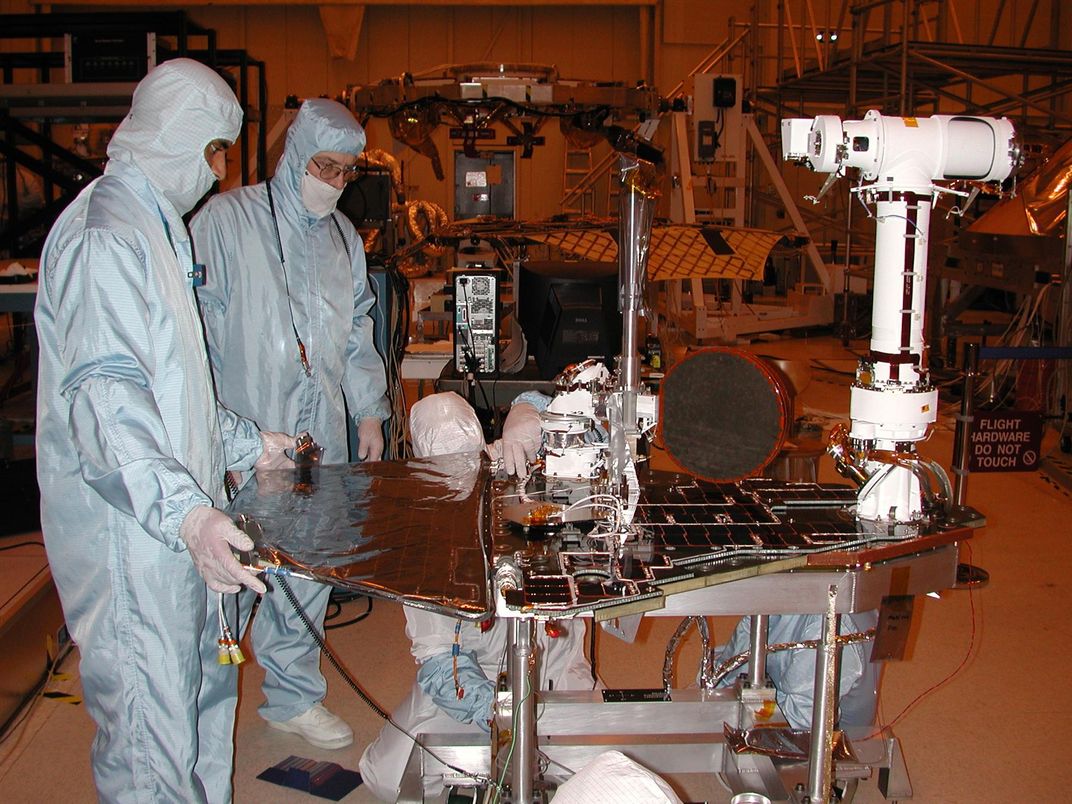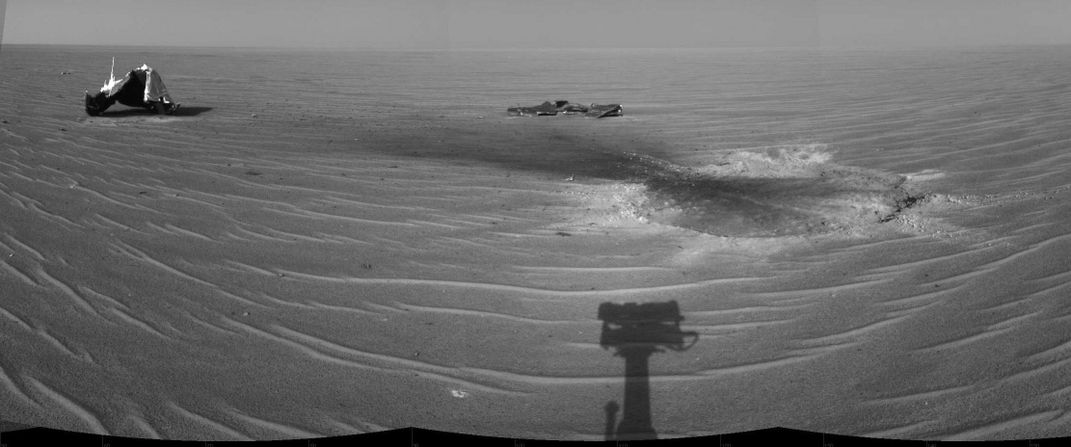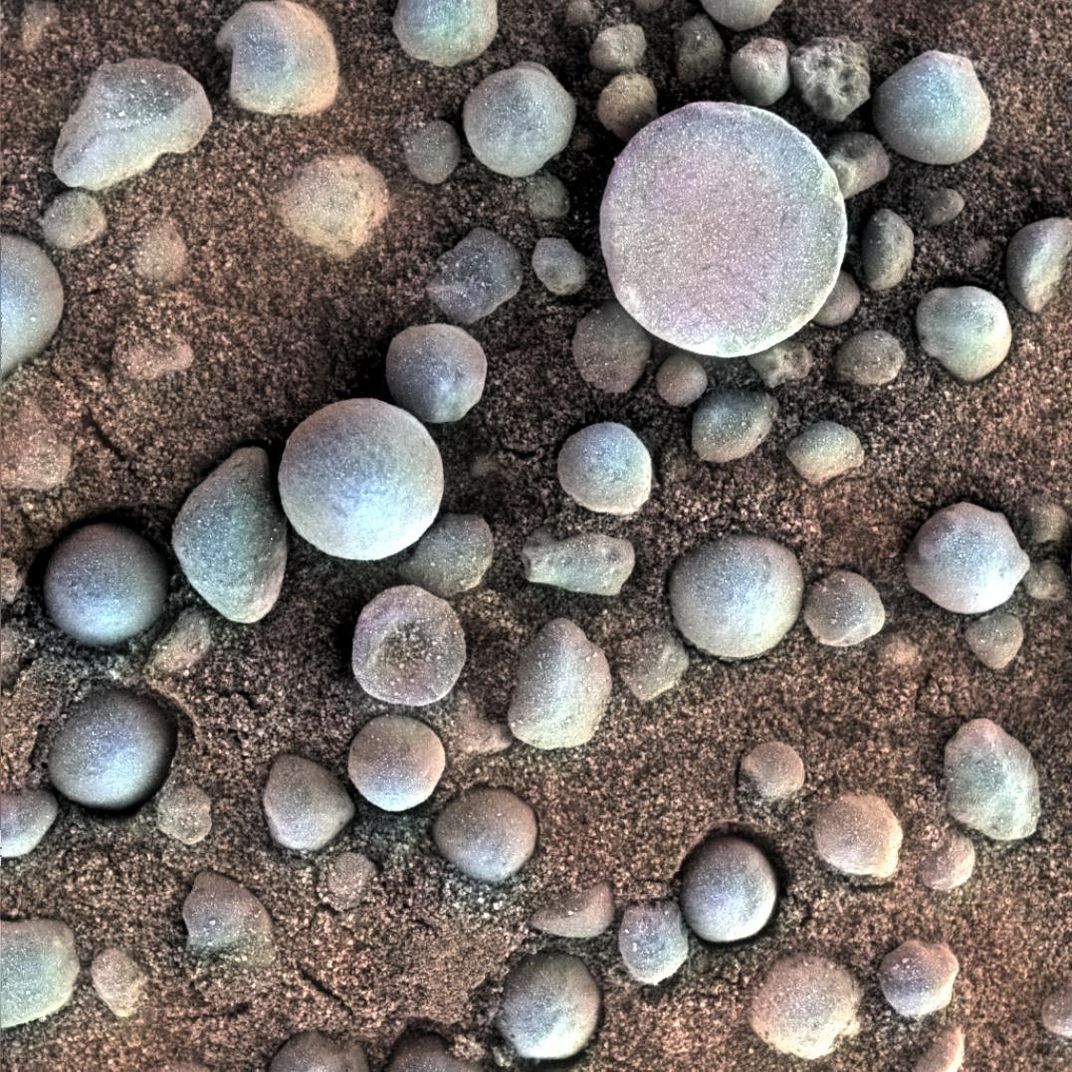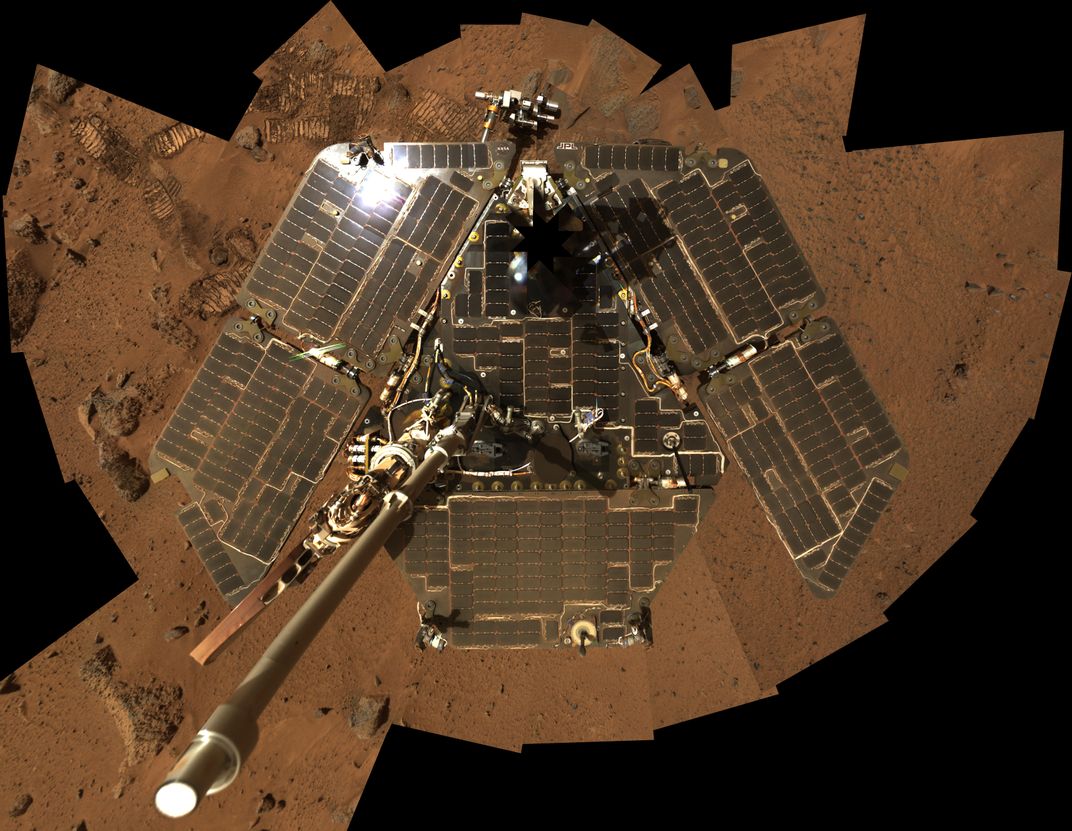How NASA’s Opportunity Rover Made Mars Part of Earth
After more than 15 years exploring the surface of Mars, the Opportunity rover has finally roved its last leg
:focal(643x502:644x503)/https://tf-cmsv2-smithsonianmag-media.s3.amazonaws.com/filer/31/00/31002851-cfd5-447f-800f-3f64a16d3356/pia08814.jpg)
On Tuesday night, engineers at the Space Flight Operations Facility of Jet Propulsion Laboratory in Pasadena, California, sent their final commands to the rover Opportunity on Mars. With no signal received in reply from the dormant rover, NASA formally announced the end of the mission today.
“I declare the Opportunity mission as complete, and with it, the Mars Exploration Rover mission as complete,” said Thomas Zurbuchen, associate administrator of NASA. “I have to tell you, this is an emotional time.”
The rover lost contact with Earth on June 10, 2018. A Mars-wide dust storm darkened the otherwise apricot skies of the fourth planet from the sun, starving the rover’s solar panels of needed sunlight. The agency maintained a vigil in hope that once the storm subsided, the rover might reawaken. During the intervening months, NASA blasted a fusillade of commands at the rover—835 in all—in case some signal might be received and operations resumed. After eight months of silence, the agency made the decision to pronounce the time of death and bid the robot farewell.
Opportunity is one-half of a two-rover mission called Mars Exploration Rovers (MER). The rovers landed separately on Mars in January 2004. Opportunity landed in Meridiani Planum near the Martian equator. Spirit, its twin, landed halfway around the planet, at the crater Gusev. The rovers primary missions were to last 90 Mars days, or sols (about 24 hours and 40 minutes). Two thousand sols later, Spirit was still sending science back to Earth, losing contact at last in 2010. Opportunity survived on Mars for over 15 years.
Today there are eight spacecraft from the world’s space agencies on or orbiting Mars, with a handful set to launch next year including NASA’s Mars 2020 rover. A frontier subdued by robotic explorers, Mars bears little resemblance to the planet we knew in 2000, when the MER mission was conceived. At the time, a single spacecraft circled the red planet: the lonely Mars Global Surveyor. NASA’s two previous, high-profile missions to Mars had both failed. Mars Polar Lander crashed into the planet, and Mars Climate Orbiter vanished, either burned up in the Martian atmosphere or deflected off into space.

MER came in the aftermath of failed mission proposals by Ray Arvidson, a professor at Washington University in St. Louis; Larry Soderblom of the U.S. Geological Survey; and Steve Squyres, a professor at Cornell University. Each of the three had been beaten by David Paige of University of California, Los Angeles, whose ill-fated Mars Polar Lander was selected for flight by NASA.
“During an [American Geophysical Union] meeting, I stopped Steve in the hall,” says Arvidson. “I said, ‘I’m a pretty sore loser. How about you?’ And that was the start.” Arvidson, Squyres and Soderblom merged their various teams and set about writing a joint proposal to get a rover on the Martian surface.
“Before Spirit and Opportunity, there was a feeling of longing to get onto the surface so that we could understand what the orbital data were telling us,” Arvidson says. “Seeing Mars from four hundred kilometers above the surface is different than looking at the rock textures and cross bedding and particle sizes and details of mineralogy and picking apart the rocks. That’s how we do geology on Earth. It would be very difficult to understand Earth the way we do just from orbital data—maybe impossible.”
It took five tries to land a mission proposal, evolving finally into a single Mars Exploration Rover. Squyres, the principal investigator of the mission, eventually convinced Dan Goldin, then-administrator of NASA, to send two rovers in case one failed.
/https://tf-cmsv2-smithsonianmag-media.s3.amazonaws.com/filer/f2/29/f229427a-0172-48c7-abe7-09cf973fe6d0/03pp2099.jpg)
The two robotic explorers were built by NASA’s Jet Propulsion Laboratory (JPL), which had previously landed the Mars Pathfinder spacecraft and its companion rover, Sojourner, in 1997. Pathfinder, which lasted 85 days, was wildly successful in the public imagination. Its little Sojourner rover traveled a whopping one hundred meters—which was one hundred meters farther than anything had ever roved on Mars before. The mission came in at $150 million dollars, and “faster, better, cheaper” became the agency mantra. After the failures of Mars Polar Lander and Mars Climate Orbiter, engineers grimly added to the mantra: “…pick two.”
MER would become an $820 million mission for both rovers—construction through prime mission—which was an unbelievable bargain, particularly considering the unexpected longevity of the spacecraft. (For comparison, Vikings 1 and 2, launched in 1975, were multi-billion-dollar landers when adjusted for inflation.)
In summer of 2003, with celestial mechanics favorable and skies over Cape Canaveral clear, the two spacecraft left Earth for their new home on another world.
Wheels on the Ground
“When I was in high school, these rovers landed,” says Heather Justice, the lead rover driver for Opportunity at JPL. “That was the first big NASA thing that I saw that really got me thinking about working in space or robotics. And I remember thinking at that time, maybe someday I’ll do something like that. I didn’t think it was going to be that mission. They were only supposed to last 90 days!”
Each rover landed using supersonic parachutes to slow down and then airbags which burst outward from all sides before the spacecraft collided with the planet. The rovers hit Mars as the world’s least-destructive meteorites, bouncing and bounding across the planet’s surface like a couple of dice in some giant's game. Opportunity eventually settled in Eagle crater on Meridiani Planum.

“There was no guarantee of success in these landings,” says Wendy Calvin, a member of the MER science team who joined the project a year before the spacecraft launched. “We had just come off these two horrific failures and there was a real sense that this could be another one. We have demonstrated our engineering so successfully, so many times since then that people forget that in 2004, we were on tenterhooks wondering how it was all going to go. No one anticipated that the landings would be so spectacularly successful as they were.”
Before the mission, she explains, planetary scientists had certain ideas about Mars, how it operated as a planet, and how it looked from the surface. “The first images down from the Opportunity landing site were really amazing because it was such a different looking planet,” she says. “I gave talks to the general public before the landing and said not to be surprised if it looked like the Sojourner landing site or the Viking landing site. But the Opportunity landing site was really, really different. And that was really cool.”
The science team chose to land at Meridiani because Mars Global Surveyor found spectral evidence of crystalline hematite at that location. “There was a lot of debate at the time of what was the cause of that,” Calvin says. “Was it rock-water interaction? Was it volcanic? I don’t think we understood Mars’s history and water cycle at all. There was so much more detail in the geologic history than we anticipated before the mission.”
Hematite is an iron oxide, commonly mined on Earth as an ore. Because the mineral forms from water interactions on this planet, the hope was that there might once have been water at Meridiani. In the early 2000s, some scientists expected to find big chunks of hematite on the surface. What waited there was a bit more unusual: tiny grayish spherules measured in millimeters and embedded in the sandstone distributed across the surface. Scientists dubbed them blueberries, thanks to their blue hue in false-color images, and they—not boulders—were the source of hematite detected from orbit. The deposits were likely created by water flowing through sandstone and then revealed by weathering. It was a (metaphorical) geologic gold mine, the evidence suggesting overwhelmingly that this place was once warm and wet.

“From orbit, it’s a plain!” Arvidson says. “We had no idea what the environment deposition was. It takes getting down there and looking at rocks at the grain scale, and looking for laminations and mud cracks and all the rest that you just can’t do from orbit. Particularly ... following the water and getting at habitability, you can’t do that in a complete way from orbital data.”
“To me,” Calvin says, “the two big discoveries are that the hematite signature discovered from orbit is in these spherules, and that we found, with Spirit, places that were basically volcanic vents with nearly pure silica.” The latter find, involving hot water interacting with rock, would have been conducive to habitability—a possible life-supporting ecosystem on Mars millions and millions of years ago, the shadow of which remains today as scars and subtle clues embedded in the rock.
Going the Distance
The silica was discovered by accident, a serendipitous side effect of a faulty wheel on the rover Spirit. The wheel jammed, and as the other five wheels dragged it along, an odd, white trench was carved in the Martian dirt. Both rovers had problems with the same wheel, either in rotation or in steering, according to Bill Nelson, the engineering manager for the MER project. “On Spirit, the right front wheel wouldn’t turn, but it would steer. On Opportunity, it would turn but it wouldn’t steer. So we submitted a NASA Lessons Learned that said that we should start leaving off the bad sixth wheel and only make five-wheeled rovers in the future.”
After the report was reviewed, Nelson says, “we soon discovered that NASA has no measurable sense of humor.”

But, according to the chief engineer, even the wheels on the rover have provided valuable insight in the discipline of terramechanics, a key to driving on other planets. “That’s a somewhat esoteric area of mechanical engineering where you study the interaction between wheels and the terrain and how things become embedded or dislodged, or how they move around and slip and so forth. Between our modeling and experience we have made real contributions there.”
Opportunity casts a long shadow over all subsequent Mars rovers, setting a gold standard of JPL engineering. Customized versions of its mobility software are used on the rovers Curiosity and upcoming Mars 2020. Fifteen years of meticulous measurements of Martian dust and its effects will be invaluable for future missions. And then there’s the rover’s durability.
“We have set the off-world record for distance,” Nelson says. “We’ve gone over 45 kilometers. Almost two years ago, we were the winners of the first Mars marathon, and I expect we will hold that record for quite some time to come. I honestly don’t think Curiosity has much hope of traveling nearly as far as we have, and it’s not really clear that Mars 2020 will, either.”
The distance traveled has been a scientific multiplier. “This was a rover that lasted a long time,” says John Callas, the MER project manager at JPL. “NASA had a requirement that to get to full mission success, you had to go at least 600 meters. So we designed this rovering system to go a kilometer—and we were totally over the moon to have that kind of capability at Mars. We never imagined we would be able to go over 45 kilometers. We’ve driven so far.
/https://tf-cmsv2-smithsonianmag-media.s3.amazonaws.com/filer/1e/87/1e87f909-9d38-46a4-91db-e2bc36b99124/mars-rover-opportunity-tracks-sol3754b-pia18605.jpg)
Eagle Crater, where Opportunity landed, is geologically in the Hesperian Period—the middle period of Mars history, roughly concurrent with the Archean Eon on Earth. In 2011, the Opportunity rover reached the Endeavor crater, which is Noachian Period rock, where the oldest geology on Mars can be studied. The last eight years have been like a bonus mission, practically a third vehicle in the MER fleet. “In a sense,” says Callas, “by driving this rover so far, we were able to drive back in time and study much older geology.”
One of the greatest contributions of this mission, Callas says, is an intangible. Every day, scientists and engineers wake up and go to work on Mars. Every day, something new is learned and Mars becomes a little more part of our world. “Until January 2004, we had these occasional visits to Mars. The Viking landers in the seventies. Pathfinder in 1997. We attempted to return in 1999 with Polar Lander. With MER, not only did we visit the surface of Mars, but we stayed there. Every day, new information about the surface of the Mars is coming in from some surface asset. We have entered the era of sustained, daily exploration of the surface of Mars.”
Fifteen years of operation with no service station in sight would be an astonishing, successful stretch for any vehicle, let alone one rolling in the inhospitable climes of Mars. The tawny, frozen, dead world that greeted Opportunity has been wholly changed in the eyes of the earthbound. What once was the inert moon, but red, is now a planet where water once flowed freely and in abundance. The question is no longer: Was Mars wet? The rover Opportunity enabled scientists to ask instead: Did something swim in those waters, and how do we find it?
/https://tf-cmsv2-smithsonianmag-media.s3.amazonaws.com/accounts/headshot/DavidBrown.png)
/https://tf-cmsv2-smithsonianmag-media.s3.amazonaws.com/accounts/headshot/DavidBrown.png)